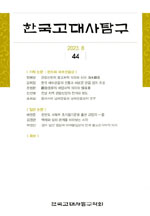삼국시대의 향로는 백제금동대향로를 중심으로 그간 많은 연구가 진행되어 왔을 뿐 고구려와 신라의 향로에 대한 연구는 없었다. 그러나 고구려와 신라도 향로를 사용하였고, 불교를 매개로 하여 발전하였던 것으로 생각된다. 고구려의 향로는 주로 고분벽화에 나타난다. 불교공인 이전의 향로는 안악3호분 벽화를 통해 파악할 수 있었고, 불교공인 이후의 향로는 쌍영총과 장천1호분의 향로를 통해 알 수 있었다. 고분벽화를 통해 본 고구려의 향로는 중국 남조의 영향이 많았음을 짐작할 수 있다. 안악3호분 묘주부인도의 향로는 중국 남조 계통의 향로를 수용한 것임을 알았고, 쌍영총 공양행렬도의 향로도 동진의 청자등 또는 청자향로와 기형면에서 유사함을 알 수 있었다. 장천1호분 불상 대좌에 나타난 향로는 기형으로 보아 豆形향로로 추정된다. 고구려에서는 병향로가 사용되었는데, 이것은 동진의 승려 담시와 관련이 있는 것으로 생각된다. 담시는 도안에 의해 정해진 계율을 고구려에 정했을 것으로 추정되고, 도안이 정한 행향도 담시의 요동 활동기간에 전해졌을 것으로 생각된다. 일본 동경국립박물관에 소장된 법륭사 헌납보물 280호인 작미형병향로는 손잡이 뒷면에는 ‘慧慈’와 ‘帶方’이라는 명문이 있어 주목된다. 이 명문의 주인공은 595년부터 612년까지 일본에서 활동한 고구려 승려 혜자로 그가 일본에서 활동했던 기간에 사용한 것으로 추정된다. 이 향로를 통해 고구려에서 작미형병향로를 사용했던 시기를 6세기 전반으로 추정하였다. 현재까지 남아 있는 가장 오래된 병향로가 521년에 개장한 하북성 경현 봉마노 묘에서 출토된 것이고, 고구려와 북위의 외교관계를 고려하면 6세기 전반 경에는 작미형병향로를 사용하였을 것으로 생각된다. 백제금동대향로에는 고구려 고분벽화의 모티프들을 비롯해 중국 남조와 북조의 도상들이 혼재되어 있다. 고구려 고분벽화의 모티프들은 인면조신을 비롯해 인면수신, 화염문, 파르티안 샷 등으로 생각된다. 북조의 도상은 외수를 통해 알 수 있었다. 백제금동대향로의 도상 중에서 코끼리를 탄 인물이나 악어 등은 고구려 고분벽화와 중국의 남북조에서는 볼 수 없는 것으로 두 도상은 백제에 직접 전래된 코끼리와 악어를 모델로 한 것으로 생각된다. 백제금동대향로는 조형적으로 중국 남조의 화상전에 나타난 박산향로와 매우 유사한데, 특히 하남성 등현 학장촌 출토 화상전에 나타난 박산향로는 백제금동대 향로와 가장 유사한 것으로 생각된다. 그리고 여기에 사용되는 향은 중국 남조의 문학작품을 통해 박산향로에 사용되는 향의 종류와 향의 형태도 알 수 있었고, 백제에서도 수지류의 향을 사용하였을 것으로 생각된다. 백제금동대향로의 제작시기는 7세기 전반으로 추정하였는데, 미륵사지 석탑에서 출토된 사리장엄구를 기준으로 하면 630년대로 추정된다. 또한 백제에서도 고구려와 같이 작미형병향로를 사용했던 것으로 추정되며, 백제는 계율을 중시하였고, 『삼국사기』의 무왕의 행향기록 등은 이것을 뒷받침한다고 할 수 있다. 신라의 향로는 단석산 마애불상군 공양자상의 병향로를 통해 확인할 수 있었고, 병향로의 발달단계를 고려하면 작미형병향로를 표현했던 것으로 생각된다. 신라에서 이와 같은 작미형병향로를 사용하게 된 것은 고구려 승려 혜량의 귀화로 추정하였다. 그가 강경에 능하였던 점을 고려하면, 신라의 작미형병향로의 사용은 혜량의 영향을 받았던 것으로 판단된다.
A study on the incense burner of Three Kingdoms period has been focused on gilt bronze incense burner of Baekje. But Goguryeo and Silla used incense burner, Buddhism was an important medium in using incense burner. Incense burner of Goguryeo was seen through the mural paintings. Incense burner before transmission of Buddhism was confirmed on Anak Tomb No.3. Ssangyeong(Twin pillars) Tomb and Jangcheon Tomb No.1 reflected the 5th century after transmission Buddhism. That of Goguryeo has something to do with southern dynasties of China in vessel type. Incense burner with handle used in Goguryeo seems to be concerned with monk Tanshi of Dongjin, China. He stayed at Liaodong from end of 4th to early 5th century. During the length of his stay, he was seemed to bring Buddhist Commandments by Ven. Daoan. Incense burner with handle in magpie’s tail of Tokyo National Museum has inscription like Hyeja and Daebang. Hyeja who was master of prince Shotoku stayed at Japan during from end of 6th to early 7th century. Through the being of this incense burner, Goguryeo was seemed to use this type incense burner at the first half of the 6th century. Gilt bronze incense burner of Baekje reflect various motif including Goguryeo, southern and nothern dynasty of China. The motif of Goguryeo mural painting is bird with human face, beast with human face, triangle flame, Partian Shot. The iconograpyh of riding elephant and crocodile is seemed to reflect the real elephant and crocodile. The origin of gilt bronze incense burner of Baekje has something to do with the boshanlu depicted on the brick with painting of southern dynasty of China. In the poems of southern dynasty of China, a various incense was recorded such as sohap incense, doryang incense, and ulgum incense. Through this poems, the incense used in this burner is similar to China. The date of gilt bronze incense burner of Baekje is the first half of the 7th century in consideration of sarira reliquary founded at stone stupa of Mireuksa temple site that was enshrined at 639. A confirmed incense burner of Silla is relief on a group of Buddha images carved on a cliff at Mt. Danseok. This incense burner belongs to incense burner with handle. In consideration of development stage, this incense burner seems to be incense burner with handle in magpie's tail. Incense burner with handle in magpie’s tail of Silla has something to do with Monk Hyeryang that was naturalized from Goguryeo to Silla.
Ⅰ. 머리말
Ⅱ. 高句麗의 香爐
Ⅲ. 百濟의 香爐
Ⅳ. 新羅의 香爐
Ⅵ. 맺음말
(0)
(0)
